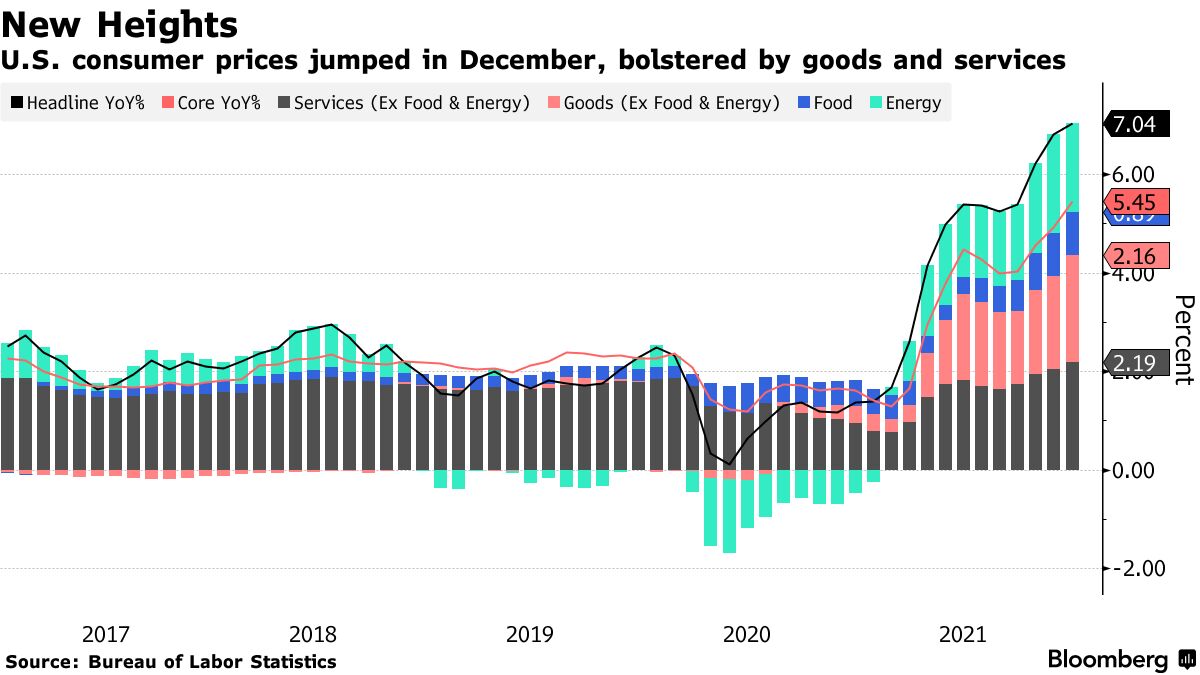Must follow the moolah, i guess
In the meantime the FED has achieve job-well-done by reaching and overtaking target
Inflation in China, under communism, results in infrastructure, not all necessary, maybe, but all employ people, assuredly
Inflation by the FED, under capitalism, results in … [fill in blank]
bloomberg.com
U.S. Inflation Hits 39-Year High of 7%, Sets Stage for Fed Hike
Reade Pickert
January 12, 2022, 10:04 PM GMT+8
U.S. consumer prices soared last year by the most in nearly four decades, illustrating red-hot inflation that sets the stage for the start of Federal Reserve interest-rate hikes as soon as March.
The consumer price index climbed 7% in 2021, the largest 12-month gain since June 1982, according to Labor Department data released Wednesday. The widely followed inflation gauge rose 0.5% from November, exceeding forecasts.
Hottest in DecadesU.S. headline inflation jumped in December by the most since 1982
Source: Bureau of Labor Statistics, Bloomberg survey
Excluding the volatile food and energy components, so-called core prices accelerated from a month earlier, rising by a larger-than-forecast 0.6%. The measure jumped 5.5% from a year earlier, the biggest advance since 1991.
Follow the reaction in real time here on Bloomberg’s TOPLive blog
The increase in the CPI was led by higher prices for shelter and used vehicles. Food costs also contributed. Energy prices, which were a key driver of inflation through most of 2021, fell last month.
The data bolster expectations that the Fed will begin raising interest rates in March, a sharp policy adjustment from the timeline projected just a few months ago. High inflation has proven more stubborn and widespread than the central bank predicted amid unprecedented demand for goods along with capacity constraints related to the supply of both labor and materials.
Meanwhile, the unemployment rate has now fallen below 4%. Against this evolving backdrop, some Fed policy makers have said that it could be appropriate to begin shrinking the central bank’s balance sheet soon after raising rates.
Market ReactionMarket expectations for Fed tightening expected in March and 2022 as a whole were largely unchanged after the report. Yields on 10-year Treasuries fluctuated while S&P 500 futures maintained gains and the dollar extended its decline on the day.
“In terms of where the Fed is on their dual mandate -- inflation and the labor market -- they’re basically there,” Michael Gapen, chief U.S. economist at Barclays Plc, said on Bloomberg Television. “I don’t really think anything stops them going in March except one of these kind of outlier events. I think they’re ready.”
The energy index declined 0.4% from November, the first monthly decline since April as gasoline prices slid. Food inflation climbed 0.5%, a slight deceleration from the previous month due to falling costs for meats.
“What we have now is a mismatch between demand and supply. We have very strong demand in areas where supply is constrained, particularly around goods, particularly around things like cars,” Fed Chair Jerome Powell told the Senate Banking Committee on Tuesday.
What's driving the global economyThe New Economy Daily dives into what the changing landscape means for policy makers, investors and you.
Sign up to this newsletter
Desperate to fill open positions, businesses are increasing pay to attract and retain workers, particularly at the lower end. But rising prices are eroding those wage advances. Inflation-adjusted average hourly earnings dropped 2.4% in December from a year earlier, the biggest drop since May, separate data showed Wednesday. However, compared with a month earlier, they rose 0.1%, the first gain in three months.
Shelter costs -- which are considered to be a more structural component of the CPI and make up about a third of the overall index -- rose 0.4% from the prior month. Other gauges of home prices and rents have surged last year, likely presaging a sharp acceleration in the report’s housing metrics this year and offering an enduring tailwind to inflation.

Omicron -- the dominant Covid-19 variant in the U.S. -- is poised to further disrupt already fragile supply chains as quarantines and illness prevent some employees from going to work. Spending on services like travel may slow, pushing down prices, but goods prices may move higher.
Read more: Trucking Trade Group Warns of Continued Shortages, Bottlenecks
Nonetheless, the impact is expected to be temporary. While economists expect CPI growth to moderate to around 3% over the course of 2022, higher rents, robust wage growth, subsequent waves of Covid-19 and lingering supply constraints all pose upside risks to the inflation outlook.
The inflation environment changed markedly in 2021 compared with the prior year when a pandemic-related slowdown in demand led to the smallest calendar-year gain in the CPI since 2015.
— With assistance by Kristy Scheuble, Olivia Rockeman, Cecile Daurat, Liz McCormick, Sophie Caronello, and Christopher Condon
(Adds graphic)
Before it's here, it's on the Bloomberg Terminal.
LEARN MORE
Sent from my iPad |





